
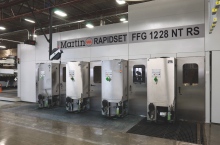
Photos by Pierre Longtin
Making a living in the highly competitive corrugated packaging industry is no picnic by any stretch, but it helps a great deal when you have your act together like the Norampac-Drummondville plant in Drummondville, Que., a key production asset of Canada’s leading paper products producer Cascades Inc.
Generating $65 million in sales last year along with two other Quebec-based Norampac sister plants—a linerboard operation in Kingsley Falls and a medium linerboard plant in Cabano—the Drummondville plant employs over 200 people over a three-shift, five days-per-week schedule to turn out a large portion of the 28,000 metric tonnes of corrugated products manufactured by Norampac last year, including high-quality board in up five colors, die-cut and glued cartons with sizes ranging from seven-inch mini-boxes to cartons 50-inches-wide, double-walled boxes, and a full range of B– and C– and specialty E-flutes.
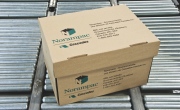
Photo by Pierre Longtin
With annual production capacity of over 800 million square feet, according to the plant’s general manager Richard Beaudoin, the busy facility has been a key beneficiary of some extensive capital spending by its owner in recent years—transforming the 25-year-old plant into one of Canada’s largest and most productive manufacturers of corrugated packaging.
BIG BOOST
“When I joined Norampac-Drummondville back in 1996, we were producing about one-third of what we currently produce, so the increase in sales and production since then has been quite impressive,” Beaudoin told Canadian Packaging in a recent interview.
“In fact, it’s why in 2009 we underwent a $10-million modernization program to ensure that our viability remains high well into the future,” says Beaudoin, crediting the company’s highly motivated and knowledgeable sales force for driving the plant’s impressive sales growth.
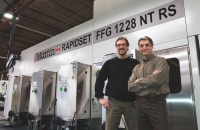
Photo by Pierre Longtin
“All of Norampac-Drummondville’s sales force are located right here in our facility,” he relates. “We are not decentralized like our competition—meaning that our sales force is more in tune with exactly what it is they are selling.
“I know it sounds quite simple, but knowing how the plant runs on a day-to-day basis is very helpful when speaking to a customer—particularly when talking about rush orders.”
With a client base of well over 600 mid-sized customers located across eastern Canada—including companies serving food-and-beverage producers, paper tissue, textile and retail sectors—the plant is looking forward to maximizing new performance capabilities enabled by recent installation of a brand new, four-color, 50-inch Rapidset FFG 1228 NT RS flexographic folder-gluer manufactured by Bobst Group Inc.’s Martin division, which was started up this past December.
“So far, it has worked absolutely perfectly—we are very happy with how it has performed for us,” says Beaudoin, praising the high quality of board processed on the Rapidset machine, as well as the system’s rapid changeover capabilities.
“One of the important features we really liked about the Bobst Martin Rapidset was just how fast and easy it is to set up during the run, as it allows our workers direct access to the flexographic units via special pits placed into the facility’s floor,” explains Beaudoin.
“While one job is running, the operators can enter the pits and do a complet set-up for the next job—there’s no time wasted.”
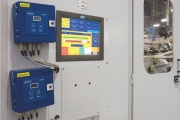
Photo by Pierre Longtin
Designed for operating speeds of up to 15,000 sheets per hour, the high-performance Rapidset FFG can produce boxes ranging in size from 3,500×700-mm up to 1,160×2,890-mm, with its inherent flexibility enabling it to produce a broad variety of regular slotted cases, die-cut boxes, and printed unfolded sheets. According to production manager Jean-François Cartier, the Rapidset machine has already had a major positive impact on product quality and consistency at the Drummondville facility.
JUST PERFECT
“We need to have consistently perfect gluing, perfect scoring, and optimal ease-of-opening, so that the first box we produce on a run is every bit as good as the last box,” states Cartier.
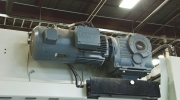
Photo by Pierre Longtin
“It’s why we decided to buy the Bobst Martin machine—it’s the best equipment of its kind out in the market,” Cartiers adds, while also crediting Bobst for the extensive training services it provided to the plant staff before, during and after installation.
“Bobst provided us with excellent training on this machine, and training is something we continually invest in to ensure that all three crews involved in operating the new Rapidset FFG do so in the exactly the same way,” he explains.
“While we appreciate that not every company uses their equipment the same way, we wanted to ensure that Norampac-Drummondville only used its equipment in the most efficient manner possible.
“It was imperative, after such a major capital expenditure, that we would start out with good work habits, and that we would continue with them,” he adds.

Photo by Pierre Longtin
Every Friday, Beaudoin relates, all three shift teams working with the Rapidset FFG get together for a training session and to review the week’s work, along with a highly-qualified equipment specialist from Jean-Claude Savard Consultants of Montreal.
“The training on the Martin Rapidset FFG has really been an eye-opening experience for us,” Beaudoin states.
“The crews have all benefited from it so much, that providing ongoing training for the rest of our crews, on all of our other equipment, is definitely something we will incorporate in the future.”
Beaudoin says the intensive training weekly session—lasting a full workday—have enabled the plant’s six operators to achieve optimal machine performance and optimal product quality after only two months, a full month ahead of schedule.
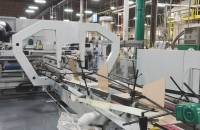
Photo by Pierre Longtin
“Every box we produce must be perfect for our customers—they demand it of us, and we also demand it of ourselves,” says Beaudoin, while listing the Drummondville plant’s other high-performance boxmaking equipment that includes:
• A made-in-Sweden, three-color Emba mini FFG unit;
• A Langston 35-inch, three-color FFG;
• A two-color, 66-inch United/Koppers rotary die-cutter;
• A three-color, 66-inch hybrid Langston/Alliance rotary die-cutter;
• A five-color, 66-inch Bobst Martin DRO rotary die-cutter;
• A BP Agnati GO-14 corrugator, which Beaudoin says is being periodically upgraded and modernized with new technologies;
• A GlueChek camera inspection system from Clearvision Technologies Inc., one of 33 such systems installed at Norampac facilities across Canada.
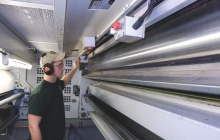
Photo by Pierre Longtin
Says Beaudoin: “The corrugated industry is a very competitive business, and our 26 Norampac corrugated
plants are performing well, but it is vitally important for us not to become complacent.
“We must not only always be on the lookout for newer and better technologies to take us to the next level,” he asserts, “but we must also perform all the required due diligence to make sure we are using all the technologies at our disposal to the best of very best of their abilities.
“It’s not very difficult to purchase equipment,” he concludes, “but knowing how to use it successfully to obtain maximum benefit from its capabilities is something that definitely takes a fair bit of work.”
Advertisement

